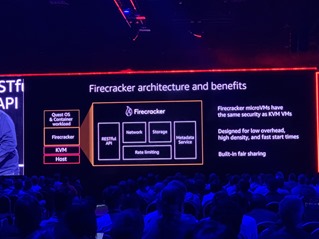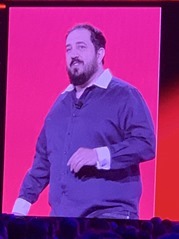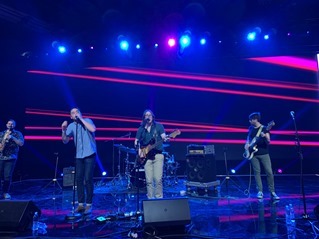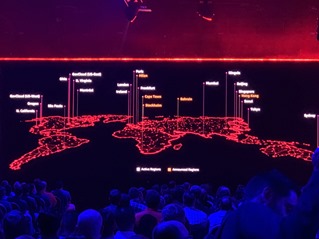AWS re:Invent 2018: Monday Night Live with Peter DeSantis
Peter is AWSs Global Infrastructure VP which he’s been now doing for a little over 2 years although he’s a company man of 20 years. Peter did his first Night Live last year (it was a Tuesday) which he took over from previous super techie guru, James Hamilton.
Peter gets to peel back some of the curtain of what AWS is working on for its global platform. As a recap, last year it was a good explanation of the Nitro system which has allowed the new bare-metal instances, which also allows VMware Cloud on AWS and Peter went through some of the networking and load-balancing. Guard Duty was also announced. There was a good warm up band.
Global Infrastructure
First up was going through the history and future announced global expansions. There haven’t actually been many new region announcements recently. Still to come online from announcements last year are Bahrain, Hong Kong SAR, and Stockholm.
There are however now plans for an AWS Region in South Africa (yay, super excited, as a South African, currently living in London but looking to move back to Cape Town, hire me please! :-)) You did know that EC2 was initially developed in Cape Town? 🙂 This new region will come online in the fist half of 2020.
Recently announced has also been a Milan, Italy region, the 6th in Europe. GovCloud (US-East) has also very recently come online which will make US Gov customers happy to be able to now offer multi-region support while still in the US after 7 years with ‘only’ GovCloud (US-West). Interestingly these two regions are operated and accessed by only US citizens or permanent residents. You need to be vetted as a US entity and root account holder. There’s an alphabet soup or certifications that these regions hold. Lots of cross region features like AMI, EBS, S3, Redshift and RDS copying is now possible. DynamoDB Global Tables and Inter-Region VPC Peering is still coming.
Peter went into details on how regions and availability zones are constructed, very specifically talking about the fault tolerance as a dig probably at Azure. The largest AZ has 14 different data centers, and the largest data center has 300,000 servers! He went through the network construct and how they actually build their network cables with a partner to put more fibers through the same conduit to reduce cost.
I was expecting some more announcements of Availability Zone expansion as currently, Canada, Seoul, Mumbai and Beijing don’t have the minimum 3 x AZs AWS is going for in each region.
AWS Global Accelerator
He went on to explain the global network and how much more efficient the AWS network is compared to the rough and ruly internet which led on to an announcement of AWS Global Accelerator. This gives you improved performance, built-in fault isolation and control for multi-region applications. Basically this is AWS providing more of its global network for customers to use. Global Accelerator uses BGP anycast which gives you an IP address that AWS announce from lots of locations on their backbone and “The Internet” figures out getting your users to the closest site. It was explained by Colm MacCárthaigh that it’s what they’ve been doing for Amazon Route 53 for 8 years now … striped, resilient, IPs. You can have multiple static IPs .. and they are meaningfully redundant, they don’t advertise the IPs on the same link.
AWS Transit Gateway
Peter then also announced Transit Gateway. Easily scale connectivity across your Amazon VPCs and accounts. This is a much waited for solution. AWS wants you to use multiple accounts but its been a pain to manage the networking between all them so this solution will be very useful to build a hub-and-spoke network topology. You can connect your existing VPCs (up to 5000), data centers, remote offices, and remote gateways to a managed Transit Gateway. Epic Games came on stage and talked about Fortnite and the massive scale they all run on AWS, more tnan 8 million concurrent players.
Peter then went through now the Nitro system allowed for more hardware specialisation as they can add Nitro to any server. General purpose CPUs have been traditionally used for everything. Now you can have more options. These can be CPUs with fewer cores yet higher clock speeds, they’ve been working with Intel for high performance CPUs, they have a 12 core 40 Ghz CPU. They also have high memory instances with up to 12 TB RAM specifically for SAP HANA. 24TB memory coming next year.
AWS Graviton Processor
AWS announced EC2 A1 instances running on a new Amazon processor called AWS Graviton which is based on ARM with custom silicon which gives 45% lower cost for scale out systems. This was developed with Annapurna Labs which AWS bought in 2015 and had developed the Nitro system. This will be available for linux workloads.
Storage
Current options are S3, EBS and EFS. Peter went through some new instances with more performance particularly for local disk options.
Networking
Lots of explanation of the global network and how they’ve evolved the data center network but also kept it very cheap to run. EC2 C5n instances were announced which are 100Gb networking capable.
HPC and Elastic Fabric Adapter
Lots of work being done to allow high performance computing to run even better. They’ve developed an internal network solution called scalable reliable datagram which doesn’t use lowly chatty TCP and provides the lowest latency for particularly HPC workloads. Elastic Fiber Adapter was announced which allows customers to bypass TCP and have direct network access.
Machine Learning
Dr. Matt Wood came up (no relation!) with an update on Machine Learning. Customers are asking to build algorithms for scale and elasticity. He announced Dynamic Training which allows you to adjust the training cluster in real time. Its currently for mxnet and gives you a 50% boost to your algorithms. New instance announced which is P3dn which uses the latest NVidia card V100 “Volta” with the 100Gb networking and plenty of other resources. SageMaker Neo announced which is a deep learning compiler to double algorithm performance. Neo will also be Open Source.
Serverless Firecracker
 At last something serverless, 90 mins of new instance types and networkifng when all this is being abstracted away, isn’t it?.
At last something serverless, 90 mins of new instance types and networkifng when all this is being abstracted away, isn’t it?.
Customers run containers for Lambda or Fargate in dedicated instances as the security boundary is not good enough in shared instances. However, this makes it inefficient even though its secure. Firecracker was announced which are MicroVMs for high security, designed for low overhead, high density and fast start times. It’s based on KVM, they take from 125 milliseconds to spin up, 150 can be launched a second and they use only 5mb memory. Thousands can be run on a single instance. Firecracker will also be open-source. We have (YALD) Yet Another Linux Distribution!
It was an interesting talk and always useful to see the hard work AWS is doing hardware and service wise, although I’m pretty sure everything talked about today is stuff AWS has been working on for a while, the real new cutting edge developmental things are still very much secret stuff!






Recent Comments